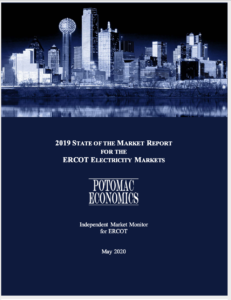The report noted that real-time energy prices generally increased as energy supplies becomes tighter, a sign of a well-functioning market.
________________________________________________
The state’s primary wholesale power market performed well last year, with relatively few generation plant outages during high heat days and energy prices rising to levels sufficient to encourage new generation investment.
Those are two of the key take-away findings from a new consultant’s report released this month. The report found the market performed competitively and that energy prices responded appropriately to demand pressures.
The primary wholesale power market in Texas is administered by a quasi-governmental organization known as ERCOT, or the Electric Reliability Council of Texas, which is overseen by the Texas Public Utility Commission. Potomac Economics, a Virginia-based consulting firm, serves as the ERCOT market’s Independent Market Monitor, and reports directly to the PUC.
Released this month, the Independent Monitor’s new “State of the Market Report” noted that real-time energy prices generally increased as energy supplies becomes tighter, a sign of a well-functioning market. In theory, added revenues from these higher prices should encourage additional generation investment.
The report noted that for the first time since 2011, net revenues for generation companies in all four ERCOT zones (Houston, South, North and West) exceeded the estimated cost for those companies to bring new natural gas-fired generators and combined-cycle generators into the market.
Market Power
The IMM report separately addressed the issue of market power — that is the ability of a single “pivotal” market player to amass enough generation capacity to unilaterally affect prices. An excess of market power or an abuse of it can undermine the competitive market.
The IMM noted that a “pivotal” supplier emerged 94 percent of the time when consumption on the grid topped 64 gigawatts. It noted that pivotal suppliers also existed during 24 percent of all hours. Although a slight improvement from 2018, the pivotal player data for 2019 suggested that “market power continued to be a potential concern in ERCOT, requiring effective mitigation measures to address it,” the IMM report noted.
Among the IMM’s other key findings:
• Peak and average energy consumption increased roughly 2 percent from 2018, with a new peak-hour demand record of 74,820 megawatts set on Aug. 21, 2019.
• Average real-time energy prices rose 32 percent in 2019, despite a 23 percent reduction in natural gas prices. The increase is attributable to higher prices resulting from energy shortage conditions during August and September.
• Relatively high prices during August and September also contributed to higher all-in real time price averages for the year. The $47 per mWh average price in 2019 was ERCOT’s highest since 2011.
• The hot weather and relatively low planning reserve margin during the summer of 2019 led to prices at or near the offer cap of $9,000 per MW for more than two hours. Prices exceeded $1,000 per mWh for more than 28 cumulative hours during 2019.
• Only 4.5 percent of ERCOT’s generation was unavailable during summer peak usage hours. This was a similar percentage as that reported in 2018, but better than the 6 percent unavailable during the 2016 and 2017 peaks. This suggests that high prices encouraged generators to better prepare for high-usage peak periods.
• Approximately 4.9 gigawatts of new generation came online during 2019, most of it wind power. The generation share from wind has increased every year since 2004, reaching almost 20 percent of annual generation in 2019, up from 19 percent in 2018 and 17 percent in 2017.
• ERCOT continued to set new records for wind output. Wind resources produced a record of 19,672 megawatts on Jan. 21. On Nov. 25, wind provided a record 58 percent of total load.
• The share of coal continues falling, down to just over 20 percent in 2019.
• Because congestion on power lines differs in different sectors of the ERCOT grid, average energy prices likewise differed by zone. As with 2018, the West Zone again experienced the highest prices during 2019 because of transmission constraints in that zone related to oil and gas production.
• Planning reserves fell to historic low of 8.6 percent during 2019. However, ERCOT expects a margin of 12.6 percent going into the summer of 2020.
• A somewhat complicated scarcity pricing mechanism created in 2014 and updated in 2019 — the Operational Reserve Demand Curve — contributed to significantly higher prices during scarcity hours in 2019.
You can download the full IMM report here.


